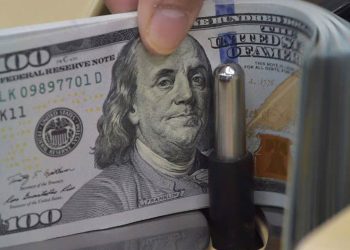The Russian ruble dipped below the symbolic threshold of 100 against the U.S. dollar during early trading hours on Tuesday. The currency’s decline was attributed to ongoing foreign currency outflows and a diminishing balance of trade, exacerbating economic challenges for Russia.
Although the ruble experienced a slight recovery as the morning progressed, it remained just above 99.5 against the greenback by around 8 a.m. London time.
This recent weakening of the ruble brought back memories of a similar occurrence in August, which prompted the Bank of Russia to convene an emergency meeting. During this meeting, the central bank made a significant move by raising interest rates by 350 basis points, pushing them to 12%.
The decision to hike interest rates followed an op-ed by one of President Vladimir Putin’s economic advisors, who attributed the plummeting currency and surging inflation to what was described as “loose monetary policy.”
In response to persistently high inflationary pressures in the Russian economy, the central bank further raised its key rate by an additional percentage point to 13% during its September meeting.
In a statement issued after the meeting, the Bank of Russia explained, “Significant proinflationary risks have crystallized, namely the domestic demand growth outpacing the output expansion capacity and the depreciation of the ruble in the summer months. Therefore, it is required to additionally tighten monetary conditions to limit the upward deviation of inflation from the target and return it to 4% in 2024.”
Russian inflation had climbed to an annual rate of 5.5% as of September 11, up from 5.2% in August and 4.3% in July. The central bank attributed this increase to the pass-through effect of the ruble’s depreciation on prices.
While some figures within the Kremlin have pointed to loose monetary policy as a factor in the ruble’s rapid depreciation, the central bank has pointed to a sharp decline in the country’s current account surplus as a significant contributing factor.
According to the Bank of Russia’s September report, the current account surplus for the period between January and August stood at $25.6 billion, marking an 86% year-on-year decrease from the corresponding period in 2022 when it was $184.8 billion. The surplus of the trade balance during the same period plummeted by 68.3%, equating to a drop of $156.7 billion.
The ruble has experienced a tumultuous journey since Russia’s invasion of Ukraine in February 2022. It hit a record low of 120 against the U.S. dollar in March 2022 but rebounded to a seven-year high just a few months later, thanks in part to capital control measures imposed by the central bank and a surge in export revenue.
However, the ruble’s recent troubles can be traced back to the impact of Western sanctions and a reversal of trade flows, coupled with a resurgence in imports, all of which have exerted significant pressure on the currency. The ruble’s future trajectory remains uncertain, as Russia grapples with economic challenges on multiple fronts.











